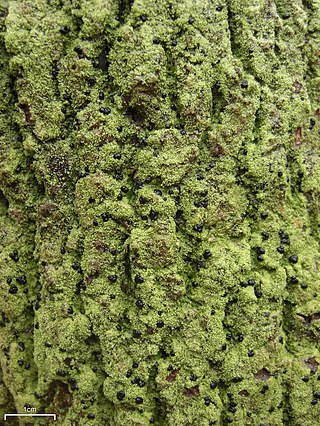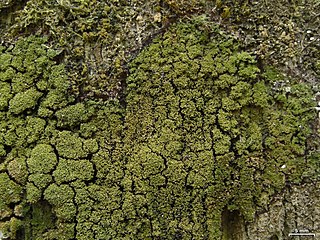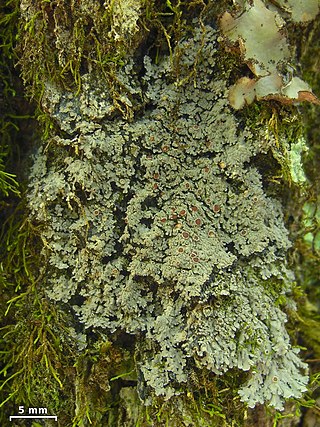Scutula is a genus of lichenicolous fungi in the family Ramalinaceae.
Biatorellaceae is a family of lichen-forming fungi in the subclass Lecanoromycetidae. The family is monotypic, and contains the single genus Biatorella, which contains eight species.

Bacidina is a genus of lichens in the family Ramalinaceae. It was circumscribed by Czech lichenologist Antonín Vězda in 1990, with Bacidina phacodes assigned as the type species. Vězda included 11 species in Bacidina, which was originally classified in the Lecideaceae. These species had previously been placed in genus Bacidia.

Bacidia is a genus of lichen-forming fungi in the family Ramalinaceae. The genus was circumscribed by Giuseppe De Notaris in 1846. Species in the genus are crust-like lichens with stemless apothecia; they have green algae as photobionts. Their asci have 8 colourless, cylindrical to acicular, multiseptate spores, with curved and thread-like conidia.
Adelolecia is a genus of crustose lichens in the family Lecanoraceae. The genus was circumscribed by Hannes Hertel and Josef Hafellner in 1984. The genus was formerly classified in the family Ramalinaceae, but molecular phylogenetic analysis showed it to belong to the Lecanoraceae.

Pilophorus is a genus of lichenized fungi in the family Cladoniaceae. They are commonly known as matchstick lichens. The genus has a widespread distribution, especially in temperate regions, and contains 11 species.
Physcidia is a genus of lichen-forming fungi in the family Ramalinaceae. The genus was circumscribed in 1862 by American lichenologist Edward Tuckerman.

Phyllopsora is a genus of lichen-forming fungi in the family Ramalinaceae. It was circumscribed by Swiss botanist Johannes Müller Argoviensis in 1894, with Phyllopsora breviuscula assigned as the type species.

Toniniopsis is a genus of crustose and squamulose lichens in the family Ramalinaceae. The genus was circumscribed by Swiss lichenologist Eduard Frey in 1926, with Toniniopsis obscura designated the type and only species. The genus name of Toniniopsis is in honour of Carlo Tonini (1803–1877), who was an Italian chemist and botanist (Lichenology), who worked in Verona and was a member and President of the Academy of Agriculture. As a result of molecular phylogenetic studies, several species, formerly classified in genus Bacidia, have been transferred to Toniniopsis.

Toninia is a genus of lichen-forming fungi in the family Ramalinaceae.

Fuscopannaria is a genus of lichen-forming fungi in the family Pannariaceae. It has 55 species.

Physconia is a genus of lichen-forming fungi in the family Physciaceae. It has about 25 species. The genus was circumscribed by Czech lichenologist Josef Poelt in 1965, with Physconia pulverulenta assigned as the type species.

Miriquidica is a genus of lichen in the family Lecanoraceae. The genus was circumscribed in 1987 by lichenologists Hannes Hertel and Gerhard Rambold, with Miriquidica complanata assigned as the type species. According to Dictionary of the Fungi, the widespread genus contains 23 species, found predominantly in arctic-alpine regions.

Rhizocarpon is a genus of crustose, saxicolous, lecideoid lichens in the family Rhizocarpaceae. The genus is common in arctic-alpine environments, but also occurs throughout temperate, subtropical, and even tropical regions. They are commonly known as map lichens because of the prothallus forming border-like bands between colonies in some species, like the common map lichen.

Hypocenomyce is a genus of lichen-forming fungi in the family Ophioparmaceae. Species in the genus grow on bark and on wood, especially on burned tree stumps and trunks in coniferous forest. Hypocenomyce lichens are widely distributed in the northern hemisphere.

Coccotrema is a genus of lichen-forming fungi. It is the type genus of the family Coccotremataceae, in the order Pertusariales. The genus contains 16 species.
Megalaria is a genus of lichen-forming fungi in the family Ramalinaceae. The genus was circumscribed by Austrian lichenologist Josef Hafellner in 1984, with Megalaria grossa assigned as the type species.
Biatora oxneri is a species of corticolous (bark-dwelling) lichen in the family Ramalinaceae. It is found in the Russian Far East and in South Korea.
Timdalia is a fungal genus in the family Acarosporaceae. It is a monotypic genus, containing the single species Timdalia intricata, a saxicolous (rock-dwelling), crustose lichen. This species was first formally described by Swedish lichenologist Adolf Hugo Magnusson in 1935, based on a collection made by Eduard Frey in Austria. It was initially classified in the genus Acarospora. Josef Hafellner circumscribed Timdalia to contain the species in 2001. It was initially placed in the family Lecanoraceae, but molecular phylogenetic studies showed Timdalia to belong in the Acarosporaceae. The genus name honours Norwegian lichenologist Einar Timdal.












